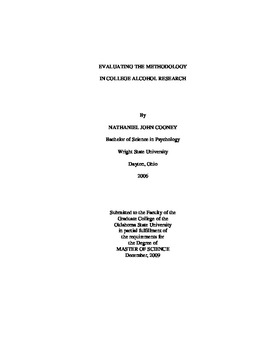| dc.contributor.advisor | Leffingwell, Thad R. | |
| dc.contributor.author | Cooney, Nathaniel John | |
| dc.date.accessioned | 2014-04-15T22:23:35Z | |
| dc.date.available | 2014-04-15T22:23:35Z | |
| dc.date.issued | 2009-12-01 | |
| dc.identifier.uri | https://hdl.handle.net/11244/9409 | |
| dc.description.abstract | The lack of a "gold-standard" of measurement in addictions research has facilitated the continued wide-spread reliance on the self-report as a primary means of collecting data, despite the field's own long-held skepticism in the veracity of that report. Secondary informants (collaterals) have often served as corroborating evidence, but the veracity of these reports has come with skepticism of its own. The current study sought not to validate the veracity of the self- or collateral-report, but rather to see if the inclusion of a collateral informant in a research study systematically altered an individual's drinking practices or the way the self-report was made. This question was explored by varying the inclusion of collateral informants as well as an independent objective measure (continuous transdermal alcohol monitoring) in a randomized control design, using a sample of college students identified as high-risk alcohol consumers. Findings and Conclusions: Self-reports of alcohol consumption made by heavy-drinking college students were not significantly impacted by the inclusion or exclusion of a collateral informant. This finding held true even when comparing the self-reports against independent objective measures of the students' actual drinking. Specifically, self-reports were no more or less consistent with transdermal reports when collateral reports were obtained. One inference that might be drawn from these findings is that while collateral reports provide additional and often valuable information in alcohol research, their mere presence does not appear to systematically impact the data collected through self-reports in the population studied. Interestingly, a strong association was observed between data collected through self-reports and through transdermal alcohol monitors, with both measures showing a high degree of correspondence. This result may lend support to the use of transdermal monitors as a measure of alcohol consumption in future research. It may further support the use of self-reports as an adequate approximation of alcohol consumption within this population, when data are collected under controlled conditions and using best available practices for assessment. | |
| dc.format | application/pdf | |
| dc.language | en_US | |
| dc.publisher | Oklahoma State University | |
| dc.rights | Copyright is held by the author who has granted the Oklahoma State University Library the non-exclusive right to share this material in its institutional repository. Contact Digital Library Services at lib-dls@okstate.edu or 405-744-9161 for the permission policy on the use, reproduction or distribution of this material. | |
| dc.title | Evaluating the Methodology in College Alcohol Research | |
| dc.type | text | |
| dc.contributor.committeeMember | Grice, James W. | |
| dc.contributor.committeeMember | Wingate, LaRicka R. | |
| osu.filename | Cooney_okstate_0664M_10702.pdf | |
| osu.college | Arts and Sciences | |
| osu.accesstype | Open Access | |
| dc.description.department | Department of Psychology | |
| dc.type.genre | Thesis | |
| dc.subject.keywords | alcohol | |
| dc.subject.keywords | alcohol research | |
| dc.subject.keywords | collateral informant | |
| dc.subject.keywords | scram | |
| dc.subject.keywords | self-report | |
| dc.subject.keywords | transdermal alcohol | |
